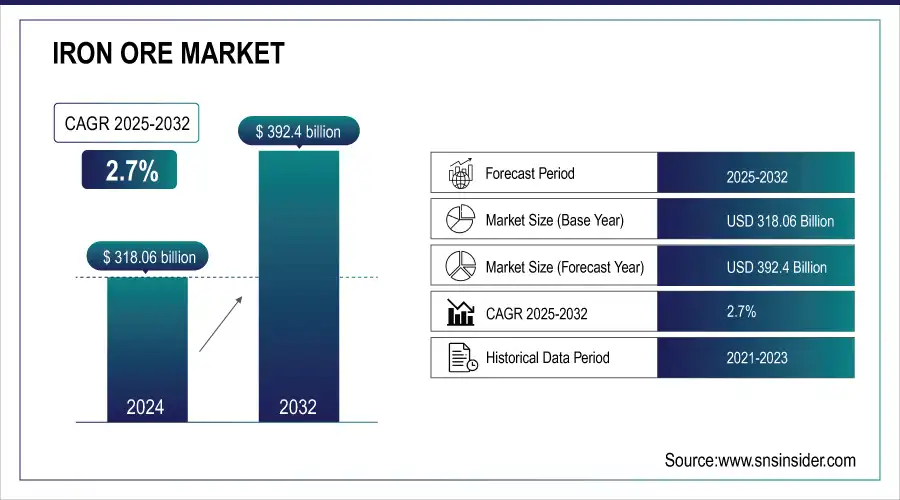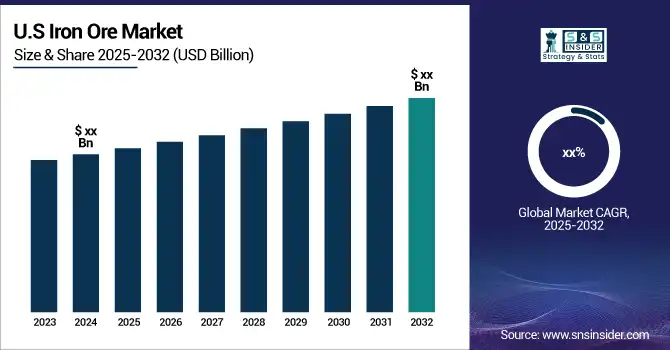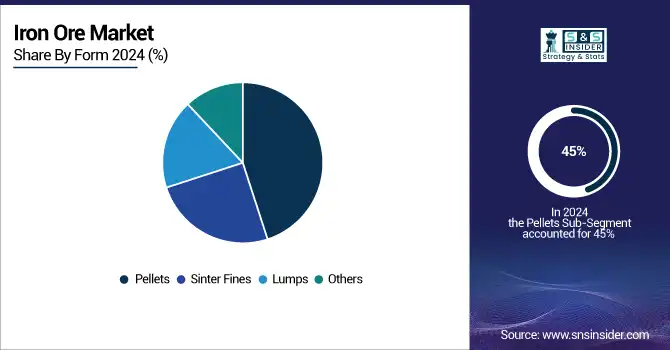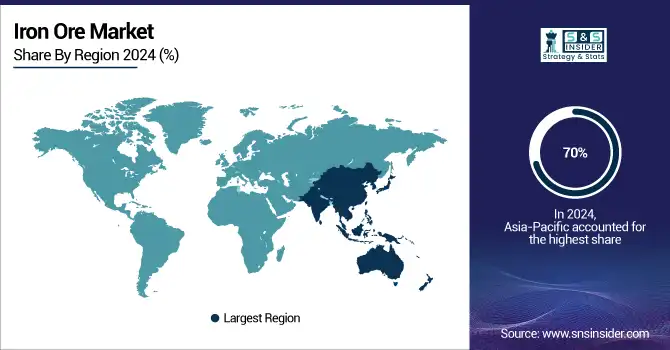Iron Ore Market Size:
The Iron Ore Market size was valued at USD 318.06 billion in 2024 and is expected to reach USD 392.4 billion by 2032, growing at a CAGR of 2.7% over the forecast period 2025-2032.
The Iron Ore market is shaped by a complex set of dynamics that influence both supply and demand on a global scale. One of the key drivers in recent months has been fluctuations in iron ore prices, largely influenced by supply-side disruptions and currency exchange rates. For example, in January 2025, iron ore prices saw a four-week high due to reduced shipments and a weaker U.S. dollar. Lower shipments, which stemmed from supply chain issues in major mining regions, limited the availability of iron ore on the global market, further contributing to price increases. The weakening of the U.S. dollar during the same period provided additional support to iron ore prices, making it more attractive for buyers from regions outside the U.S. Furthermore, government policies and industrial regulations also play a significant role in shaping the market. A major policy shift in October 2024 required steel manufacturers in India to use iron ore fines, which are typically a waste product, in steel production. This new regulation was aimed at improving the efficiency of steel manufacturing and reducing waste, creating fresh demand for iron ore fines. This shift in policy by the Indian government reflects the evolving industrial approach to resource utilization and cost efficiency in steelmaking.

To Get more information on Iron Ore Market - Request Free Sample Report
In terms of developments by key players in the market, significant progress has been observed in operational improvements and production increases. In January 2025, BHP reported a notable rise in production levels and an enhanced focus on efficiency. This included advancements in technology that streamlined operations, further boosting the company's output and reducing operational costs. These efforts are becoming essential in maintaining profitability amid fluctuating commodity prices and global demand. Additionally, in the same month, Ukrainian seaports reported handling 18.5 million tons of iron ore, showcasing a steady flow of raw materials through crucial shipping routes. This reflects an important aspect of the market, as port and logistical capacities directly affect the availability and cost of iron ore globally. Similarly, in January 2025, a development was noted in iron ore prices due to supply-side disruptions in key mining regions, with several companies adjusting their operations to adapt to the changing conditions. These advancements, alongside strategic shifts in mining operations by major players such as BHP, continue to shape the industry's trajectory.

Market Size and Forecast:
-
Market Size in 2024 USD 318.06 Billion
-
Market Size by 2032 USD 392.4 Billion
-
CAGR of 2.7% From 2025 to 2032
-
Base Year 2024
-
Forecast Period 2025-2032
-
Historical Data 2021-2023
Iron Ore Market Trends:
-
Preference for premium-grade iron ore, such as lump ore and pellets, is rising due to higher efficiency, better yield, and reduced operational costs in steelmaking.
-
Large steel producers in China, India, and Japan are driving demand for high-quality ore to meet industrialization and infrastructure growth needs.
-
Advanced steelmaking technologies, particularly electric arc furnaces, are increasing the requirement for more refined raw materials.
-
The automotive industry is boosting iron ore demand through its need for high-strength, lightweight steel in fuel-efficient vehicles.
-
Rapid growth in the global construction sector continues to generate strong demand for steel, thereby supporting iron ore market expansion.
Iron Ore Market Growth Drivers:
The increasing demand for high-quality iron ore is a significant driver of market growth. Steel manufacturers prefer high-quality iron ore—specifically lump ore and pellets—due to its higher efficiency in the production process. High-grade ore results in better yield, higher quality steel, and lower operational costs during steel production. This preference for premium iron ore is particularly prevalent among large steel producers, such as those in China, India, and Japan, where the demand for top-quality steel remains high due to continued industrialization and infrastructure expansion. High-quality iron ore enables steelmakers to produce stronger, more durable steel with fewer impurities, which is critical for meeting the stringent requirements of modern construction and automotive industries. The demand for such ore is rising steadily as steelmakers aim to improve their efficiency and profitability in a competitive market. Consequently, iron ore miners that can supply premium-quality ore are positioned to benefit from this trend. Furthermore, the increasing adoption of advanced steelmaking technologies—such as electric arc furnaces—further boosts the demand for high-quality ore, as these technologies require more refined raw materials for optimal performance. This trend of increasing demand for high-quality iron ore is expected to continue, contributing to the overall growth of the iron ore market.
Iron Ore Market Restraints:
Environmental regulations and sustainability concerns are significant challenges for the iron ore market. Stricter global regulations aim to reduce the ecological impact of mining, focusing on pollution control, carbon emissions reduction, and responsible resource use. Companies are now required to meet higher environmental standards, including reclamation plans and land restoration, which increase operational costs. Additionally, some countries limit mining permits due to concerns over resource depletion, further restricting supply. While environmental compliance is essential for sustainable development, it raises operational costs and reduces profit margins, impacting overall market growth.
Iron Ore Market Opportunities:
Rising steel consumption in the automotive and construction industries presents another key opportunity for the iron ore market. Steel is a critical component in the manufacturing of automobiles, infrastructure, and buildings, and these industries continue to grow globally. The automotive sector, in particular, is increasing its demand for high-strength, lightweight steel for use in car manufacturing, driven by consumer demand for fuel-efficient and durable vehicles. Similarly, the global construction industry remains robust, with continuous demand for steel in the development of commercial, residential, and industrial buildings. This surge in steel consumption directly translates into higher demand for iron ore, which is the primary raw material for steel production. As the automotive and construction industries continue to expand, the need for iron ore will rise, offering a significant growth opportunity for suppliers. In particular, countries with rapidly growing automotive and construction sectors, such as India and China, will play a key role in driving the demand for iron ore in the coming years.
| Iron Ore Grade | Description | Typical Fe Content (%) | Common Applications | Processing Requirement |
|---|---|---|---|---|
| High-Grade Ore (Hematite) | Dense and rich in iron, low in impurities | 60-70% | Steel production, blast furnaces | Minimal processing, direct use |
| Medium-Grade Ore (Magnetite) | Requires processing to separate iron from impurities | 50-60% | Steel production, pelletizing | Requires beneficiation |
| Low-Grade Ore | Contains higher levels of impurities | 45-50% | Iron-making, sometimes blended | Requires extensive beneficiation |
| Pelletized Ore | Iron ore processed into pellets for ease of use | 62-65% | Direct reduction in steel mills | Requires pelletizing process |
| Lump Ore | Naturally mined ore, larger pieces | 58-62% | Direct reduction in steel mills | Limited processing required |
The iron ore market is primarily divided based on the quality and grade of the ore, which influences its suitability for various industrial applications. High-grade ores, such as hematite, typically have a high iron content (60-70%) and require minimal processing, making them ideal for steel production in blast furnaces. Medium-grade ores like magnetite (50-60% Fe) require beneficiation to remove impurities before use. Low-grade ores, with iron content around 45-50%, necessitate extensive processing due to their high impurity levels. Pelletized ores, typically in the 62-65% Fe range, are favored for the direct reduction in steelmaking, while lump ores (58-62% Fe) offer a direct method for steel production but require limited processing. The quality and grade distribution of iron ore directly impact its cost, processing requirements, and overall demand in the steel industry.
Iron Ore Market Segment Analysis:
By Form
In 2024, Pellets form dominated the iron ore market, holding a market share of 45%. Pellets are produced through the agglomeration of iron ore fines and are characterized by their uniform size and high iron content, typically around 62-65% Fe. The preference for pellets is driven by their suitability for use in direct reduction iron (DRI) processes, particularly in electric arc furnaces, which have gained popularity due to their efficiency and lower environmental impact. The global steel industry’s shift towards cleaner production methods has spurred the demand for high-quality pellets, making them essential for steelmakers aiming to improve their productivity and reduce emissions. Major iron ore producers, including Vale and Rio Tinto, have significantly invested in pelletizing facilities to meet this growing demand. Additionally, the ability of pellets to reduce slag formation in steelmaking furnaces enhances their appeal to manufacturers. As the steel industry continues to evolve, the dominance of pellets as a preferred form of iron ore is expected to persist, driving growth in this segment.

By Type
In 2024, Hematite dominated the iron ore market with a market share of 60%. This high-grade iron ore is characterized by its dense composition and elevated iron content, typically ranging from 60% to 70%. Hematite's prominence in the market is primarily due to its suitability for steel production, particularly in blast furnaces. Steel manufacturers prefer hematite because it requires minimal processing, resulting in lower production costs and higher operational efficiency. Countries like China and India are significant consumers of hematite, driving their demand as they ramp up their steel production to meet growing infrastructure and industrial needs. Furthermore, hematite’s relative abundance and established supply chains contribute to its market dominance. Major players like Vale and Rio Tinto focusing on hematite extraction to cater to the high-quality requirements of the steel industry. The ongoing expansion of the construction and manufacturing sectors globally ensures that hematite remains a crucial player in the iron ore market, reinforcing its position as the leading type of iron ore in 2024.
By Grade
In 2024, the High-grade iron ore segment dominated the iron ore market, accounting for a market share of 55%. High-grade iron ore, particularly hematite, is characterized by its elevated iron content, generally between 60% and 70%. This grade of iron ore is favored by steel manufacturers due to its efficiency in steel production processes. High-grade ore allows for reduced energy consumption and higher productivity in blast furnaces, making it a more economically viable option compared to lower-grade ores. As the global steel industry expands, especially in developing economies, the demand for high-grade iron ore continues to rise, driving its market dominance. Additionally, high-grade iron ore is less expensive to process, which further enhances its appeal to steel producers. Countries like China, which is the largest consumer of iron ore, heavily rely on high-grade ore to meet their steelmaking needs. The strategic focus on high-grade ore by major iron ore producers ensures its continued relevance in the market, solidifying its position as the preferred choice for steel production in 2023.
By Application
In 2024, the Steel Manufacturing segment dominated the iron ore market, capturing a market share of 70%. Iron ore serves as the primary raw material in steel production, which is critical for various industries, including construction, automotive, and infrastructure development. The steel demand has been consistently rising, particularly in developing nations where urbanization and infrastructure projects are accelerating. As economies grow, the requirement for robust and durable materials like steel becomes essential, further driving the need for iron ore. Steel manufacturers seek high-quality iron ore to optimize their production processes, reduce costs, and enhance the mechanical properties of the final steel products. The continuous investment in infrastructure projects globally, including residential and commercial buildings, transportation networks, and energy facilities, significantly contributes to the high consumption of steel and, consequently, iron ore. This growing emphasis on steel manufacturing solidifies its status as the leading application for iron ore, ensuring sustained demand in the market as industries evolve and expand.
By End-Use Industry
In 2024, the Construction industry dominated the iron ore market, holding a market share of 40%. The construction industry is one of the largest consumers of steel, which is predominantly derived from iron ore. The ongoing global trend of urbanization and infrastructure development has led to a significant rise in demand for steel products, ranging from beams and rebar to structural components for buildings and bridges. As countries invest heavily in infrastructure to support population growth and economic development, the demand for high-quality iron ore to produce steel has intensified. Additionally, the shift towards sustainable construction practices has further increased the need for durable and reliable materials, driving the preference for steel made from high-grade iron ore. Major infrastructure projects, including transportation networks, residential developments, and commercial complexes, require substantial quantities of steel, which directly translates to robust demand for iron ore. This ongoing growth in the construction sector highlights its pivotal role in the iron ore market, ensuring its position as the leading end-use industry in 2023.
Iron Ore Market Regional Analysis:
Asia Pacific Iron Ore Market Insights
In 2024, Asia Pacific dominated the global iron ore market, with a market share of 70%. The primary driving force behind Asia’s dominance is China, the world's largest importer, and consumer of iron ore. China accounts for approximately 60% of global iron ore imports, utilizing the mineral for its massive steel production sector, which supports the country's vast infrastructure and industrial growth. Iron ore demand in China is projected to continue growing as the government focuses on expanding its urbanization initiatives and infrastructure projects. India, another major player in Asia, is also contributing to the region's dominance, with increasing iron ore production driven by expanding steel manufacturing and construction sectors. Additionally, countries like Japan and South Korea are major consumers of iron ore as well, largely due to their thriving automotive and manufacturing industries.

Get Customized Report as per Your Business Requirement - Enquiry Now
North America Iron Ore Market Insights
The North America iron ore market benefits from established steel production facilities and advanced mining operations, particularly in the U.S. and Canada. Demand is driven by infrastructure upgrades, automotive manufacturing, and renewable energy projects, supporting steady growth while emphasizing sustainable mining and the supply of high-quality ore.
Asia Pacific Iron Ore Market Insights
Asia Pacific dominates the iron ore market, led by China, India, and Japan, where industrialization, construction, and automotive sectors drive significant demand. Rising steel production capacity, government-led infrastructure projects, and strong raw material requirements position the region as the largest consumer and growth engine for the iron ore industry.
Europe Iron Ore Market Insights
Europe’s iron ore market is shaped by its robust automotive and construction industries, along with a growing shift toward low-carbon steel production. Demand for high-quality ore is rising as the region invests in green technologies, circular economy practices, and sustainable mining partnerships to reduce reliance on external suppliers.
Latin America (LATAM) and Middle East & Africa (MEA) Iron Ore Market Insights
LATAM, led by Brazil, is a key global supplier with vast reserves and strong export orientation, particularly to Asia. MEA shows growing demand fueled by infrastructure projects and industrial expansion. Both regions benefit from rising foreign investment, supporting mining capacity expansion and increased integration into the global steel supply chain.
Iron Ore Market Key Players:
-
Ansteel Group Corporation Limited (Iron ore pellets, Iron ore concentrate)
-
Anglo American (Iron ore fines, Iron ore lumps)
-
ArcelorMittal (Iron ore pellets, Iron ore concentrate)
-
BHP (Iron ore fines, Iron ore lump)
-
Cleveland-Cliffs Inc. (Iron ore pellets, Iron ore concentrate)
-
EVRAZ PLC (Iron ore concentrate, Iron ore pellets)
-
Fortescue Metals Group Ltd (Iron ore fines, Iron ore pellets)
-
HBIS Group (Iron ore concentrate, Iron ore pellets)
-
LKAB (Iron ore pellets, Iron ore fines)
-
METALLOINVEST (Iron ore concentrate, Iron ore pellets)
-
Metalloinvest MC LLC (Iron ore concentrate, Iron ore pellets)
-
Niron Metals (Iron ore pellets, Iron ore fines)
-
Palabora Mining Company (Iron ore concentrate, Iron ore pellets)
-
Rio Tinto (Iron ore fines, Iron ore lumps)
-
Shaanxi Coal and Chemical Industry Group (Iron ore concentrate, Iron ore fines)
-
South32 (Iron ore fines, Iron ore lumps)
-
Tata Steel (Iron ore pellets, Iron ore fines)
-
Thyssenkrupp AG (Iron ore pellets, Iron ore concentrate)
-
Vale (Iron ore fines, Iron ore pellets)
-
Waratah Coal (Iron ore fines, Iron ore concentrate)
Competitive Landscape for Iron Ore Market:
BHP is one of the world’s largest iron ore producers, with major operations in Western Australia’s Pilbara region. The company supplies high-quality iron ore fines and lumps to global steelmakers, particularly in Asia. Its focus on efficiency, sustainability, and large-scale production strengthens its leadership in the global iron ore market.
-
January 2025: BHP reported increased iron ore and copper production in the December quarter, driven by efficiency improvements at major sites like South Flank. Despite global copper production challenges, BHP plans significant investments, particularly in Chile's Escondida mine, anticipating a copper supply deficit by the 2030s.
-
February 2024: Indian authorities are considering an export tax on low-grade iron ore due to rising domestic demand, despite opposition from the Federation of Indian Mineral Industries. Smaller steel manufacturers support the potential tax, as steel exports from China are increasing India's steel demand.
| Report Attributes | Details |
|---|---|
| Market Size in 2024 | USD 318.06 Billion |
| Market Size by 2032 | USD 392.4 Billion |
| CAGR | CAGR of 2.7% From 2025 to 2032 |
| Base Year | 2024 |
| Forecast Period | 2025-2032 |
| Historical Data | 2021-2023 |
| Report Scope & Coverage | Market Size, Segments Analysis, Competitive Landscape, Regional Analysis, DROC & SWOT Analysis, Forecast Outlook |
| Key Segments | • By Type (Hematite, Magnetite, Limonite, Siderite, Others) • By Form (Sinter Fines, Lumps, Pellets, Others) • By Grade (High-grade, Medium-grade, Low-grade) • By Application (Steel Manufacturing, Iron Production, Others) • By End-Use Industry (Construction, Automotive, Shipbuilding, Energy, Others) |
| Regional Analysis/Coverage | North America (US, Canada), Europe (Germany, UK, France, Italy, Spain, Russia, Poland, Rest of Europe), Asia Pacific (China, India, Japan, South Korea, Australia, ASEAN Countries, Rest of Asia Pacific), Middle East & Africa (UAE, Saudi Arabia, Qatar, South Africa, Rest of Middle East & Africa), Latin America (Brazil, Argentina, Mexico, Colombia, Rest of Latin America). |
| Company Profiles | Vale, Rio Tinto, BHP, Fortescue Metals Group Ltd, Ansteel Group Corporation Limited, ArcelorMittal, METALLOINVEST, Cleveland-Cliffs Inc., HBIS Group, Anglo Americanand other key players |

